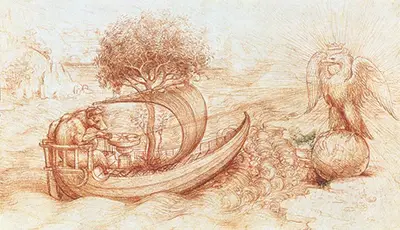The painting is particularly fascinating to modern art critics and historians due to the amount of historical symbolism which Da Vinci manages to pack into one image. It is also a fine example of Da Vinci's expertise in perspective.
Art historians believe that the painting is a reference to the meeting between Pope Leo X and King Francois I. It is also generally believed that the painting was made in celebration of the wedding between Giuliano de Medici and Philiberta of Savoy.
The wolf is believed to represent either the Pope or the Roman Catholic Church as a whole. The crowned eagle sitting atop the globe is thought to represent the French monarch and the land may serve as a representation of the power of the German emperor at that time.
The figures depicted in Allegory of Boat Wolf and Eagle are so striking as to almost reach the level of caricature. It is possible to interpret Da Vinci's image as a very early example of a political cartoon.
There is certainly reference to current events in the drawing and whilst it is less obvious than in some modern political cartoons, it is not particularly hard to discern Da Vinci's point of view.
From a technical point of view, Allegory of Boat Wolf and Eagle is a very high quality drawing. There is a clear sense of perspective (although the tree in the background does sit somewhat closer to the boat that it probably should) and the true feeling that this drawing represents a snapshot from a moving scene, rather than a staged scene as was common in many other paintings and drawings of the time.
The figure of the eagle is clearly the regal and more powerful figure of the two and draws the viewer's eye long before any attention is paid to the creature in the boat. If the wolf is intended, as many critics suspect, to represent the church, then it is notable that Da Vinci has chosen a fairly negative image and shoved it into the background of the image.
Allegory of Boat Wolf and Eagle is an interesting example of a 'pure' artwork from this period in Da Vinci's life. There is no particular scientific emphasis in the image and it sits clearly within the 'artistic' side of Da Vinci's output. However, as with all of Da Vinci's output, it's possible to read a lot into the message that Da Vinci may have been attempting to convey.
The notion of political satire is an interesting departure for Da Vinci as this is not a theme that comes across in many of his other works, which tend to take a much more rigid and scientific approach.


